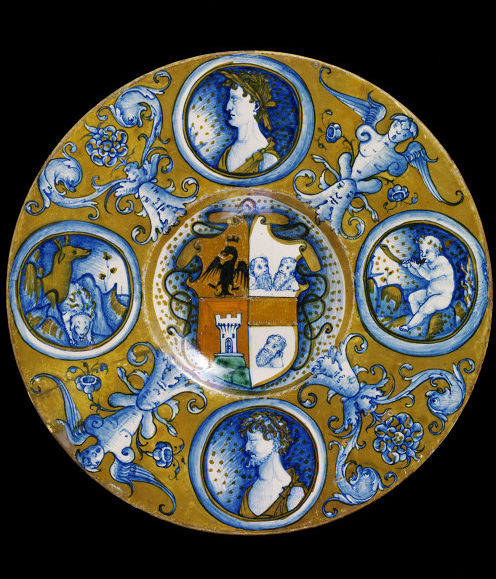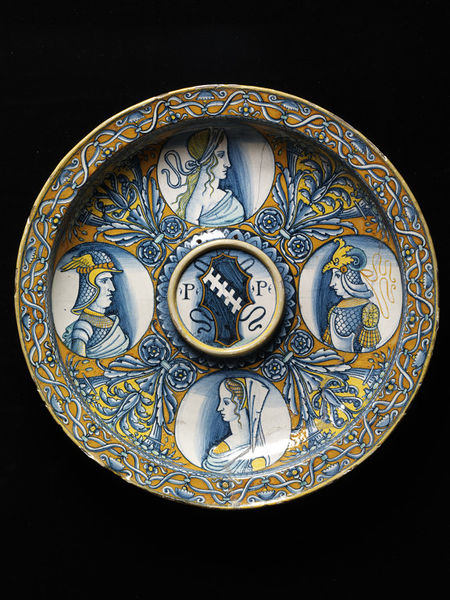A&S 50 has come (by far) and I have completed my challenge. There are still a few items in the queue for firing, and some individual items for 33 are still waiting completion but on the whole I believe I have successfully met this challenge. I have taught myself how to paint ceramics. I have learned a variety of techniques and tools. I have also reached a great many individual items and cultures. I entered two Fields of Gold A&S competitions and one Kingdom competition, placing first in one FoG and one Kingdom competition. I have given away the vast majority of items or donated them as fighter auction prizes. I have learned a significant amount about blue on white ceramic objects and have applied this knowledge not only to my ceramics work but also to deducing time periods depicted in medieval art. I still have at least three more essays on BoW items to go with Uzbekistan, Italy and China still in draft form.
Below I have summarised my projects in a handy dandy table but for those who don't like tables as much as I do, some reflections.
- I'm still in love with Sultanabad, mostly because of the blue and turquoise colours.
- I love Kashan tiles but this project is probably too big for me.
- I've made a lot of Italian and I believe this is because the opaque palette I have to work with fits the maiolica style best
- Pretty much everything is after the 1300's because this is when ways to fire polychrome items in a stable manner were invented.
| Plate | Item | Style | Culture | Age |
| 1 | My household plate | Lusterware | Spanish | 15th C |
| 2 | Gabriel's Plate | Tin Glazed earthenware | Spanish, Seville or Valencia | 1525-1550 |
| 3 | Constanzia's Plate | Tin Glazed earthenware | Spanish, Seville or Valencia | 1550-1600 |
| 4 | Relief experiment | Lusterware | Spanish, Reus | 1575-1600 |
| 5 | Ibis plate | Luserware | Spanish, Manises | 1525-1575 |
| 6 | Drollery plate 1 | Illumination | N/A | N/A |
| 7 | Drollery plate 1 | Illumination | N/A | N/A |
| 8 | Peacock plate | Stonepaste with under-glaze decoration | Syrian | 12th C |
| 9 | Dove plate | Earthenware | Iran | 14th C |
| 10 | Rohans household plate | Lusterware | Spanish | 15th C |
| 11 | Hare and artichoke bowl | Tin Glazed earthenware | Italy, Florence | 1450 |
| 12 | Mirriams serving plate | Tin Glazed earthenware | Spanish, Manises | 1400-1450 |
| 13 | Tile 1 | Stonepaste with lustre over white underglaze | Kashan, Iran | 1263 |
| 14 | Tile 2 | Stonepaste with lustre over white underglaze | Kashan, Iran | 14th C |
| 15 | Tile 3 | Stonepaste with lustre over white underglaze | Kashan, Iran | 1260-1270 |
| 16 | Tile 4 | Stonepaste with lustre over white underglaze | Kashan Iran | 13th C |
| 17 | Tile 5 | Stonepaste with lustre over white underglaze | Kashan, Iran | 14th C |
| 18 | Tile 6 | Stonepaste with lustre over white underglaze | Kashan, Iran | 13th C |
| 19 | Tile 7 | Stonepaste with lustre over white underglaze | Iran | 13th C |
| 20 | Pheasant Plate | Stonepaste with overglaze lustre | Kashan, Iran | 12th C |
| 21 | Escher Plate | Geometrical line drawing with pigment | Modern | Modern-ish |
| 22 | Tile 8 | Stonepaste with lustre over white underglaze | Iran | 13th C |
| 23 | Fox Plate | Wooden plate with gesso and varnish | Egypt | 13-14th C |
| 24 | Tile 9 | Stonepaste with lustre over white underglaze | Iran | 13th C |
| 25 | Tile 10 | Stonepaste with lustre over white underglaze | Iran | 1262 |
| 26 | Iznik Plate | Polychrome underglaze | Iznik | 1575 |
| 27 | Janet's Plate | Lustreware | Manises, Spain | 1400-1450 |
| 28 | Cat Cup 1 | Lustreware | Manises, Spain | 1400-1450 |
| 29 | Cat Cup 2 | Lustreware | Manises, Spain | 1400-1450 |
| 30 | Stromhold Fidchel board | Carved wood | Isle of Man | 10th C |
| 31 | Peacock cup | Polychrome underglaze | Italy, Florence | 1515 |
| 32 | Janets Bowl | Lustreware | Manises, Spain | 1400-1450 |
| 33 | cups* | Polychrome underglaze | N/A | N/A |
| 34 | Krae Glas Baronial platter | Polychrome underglaze | Italy | 1525 |
| 35 | Aneala cups | Polychrome underglaze | N/A | N/A |
| 36 | Aneala plates | Polychrome underglaze | Italy | 1525-1530 |
| 37 | Dr Suess bowl and Plate | Cobalt underglaze | Italy | 15th C |
| 38 | BoW Iranian cup | Cobalt underglaze | Iran | 1450-1500 |
| 39 | BoW Turkey cup | Cobalt underglaze | Iznik, Turkey | 1550's |
| 40 | BoW Spanish cup | Cobalt underglaze | Spain | 1550's |
| 41 | BoW Italian cup | Cobalt underglaze | Tuscany, Italy | 1575-1625 |
| 42 | Bowl for Tamar | Polychrome underglaze | Italy | 16th C |
| 43 | Plate for Tamar | Polychrome underglaze | Italy | 16th C |
| 44 | V's cup | Cobalt underglaze | Valencia, Italy | 15th C |
| 45 | Foxy bowl | Lustreware | Sultanabad, Iran | 13th C |
| 46 | Plate of love | Polychrome underglaze | Italy | 1550's |
| 47 | Tile 11* | Stonepaste with lustre over white underglaze | Kashan, Iran | 13th - 14th C |
| 48 | Tile 12* | Stonepaste with lustre over white underglaze | Kashan, Iran | 13th - 14th C |
| 49 | Tile 13* | Stonepaste with lustre over white underglaze | Kashan, Iran | 13th - 14th C |
| 50 | Starwars maiolica | Polychrome underglaze | Deruta, Italy | 1525 |
| * Items 47, 48 and 49 still to be fired | ||||
| * Collection of items for 33 half way completed & delivered | ||||





























.jpg)
.jpg)










.png)



